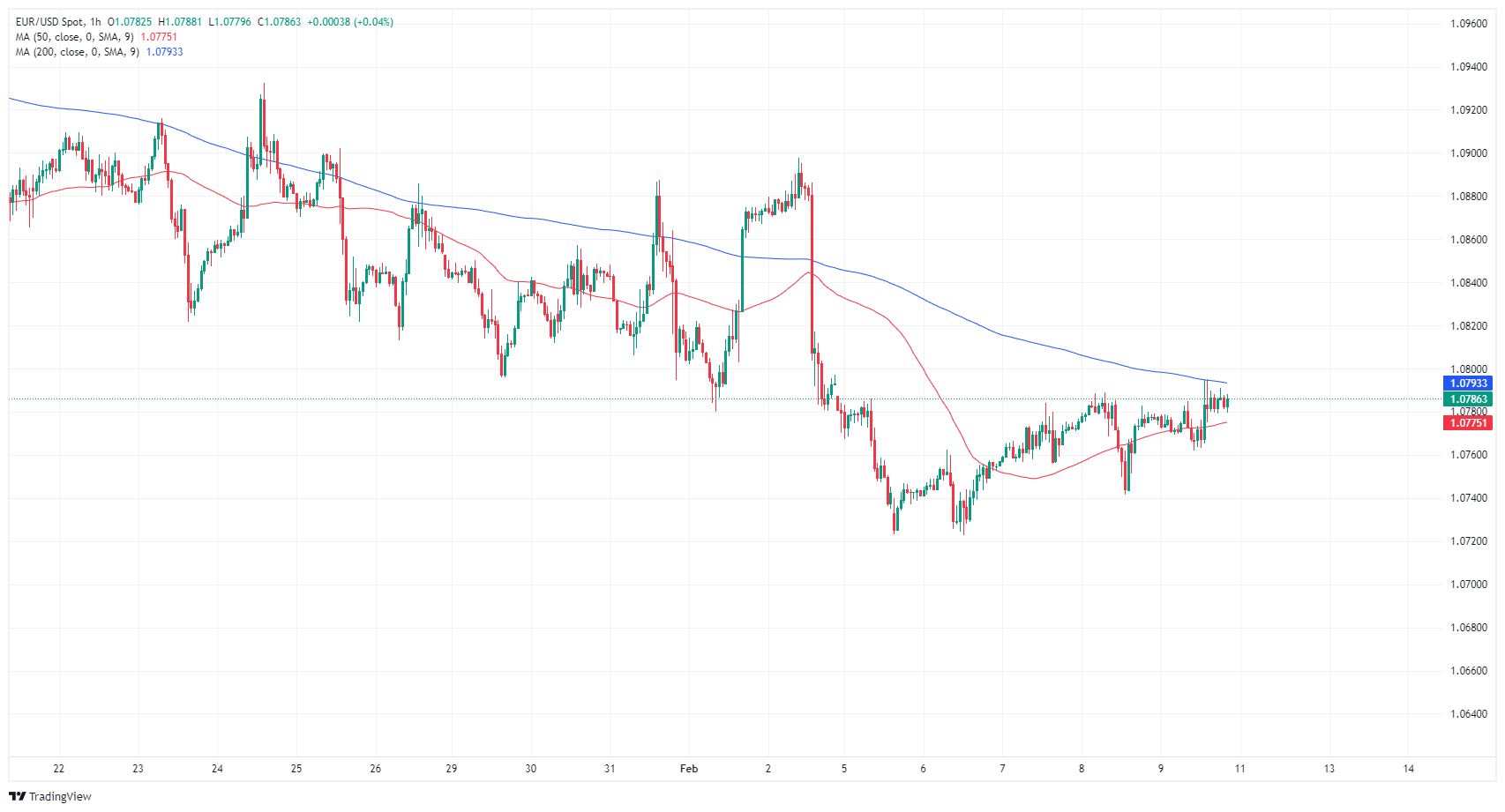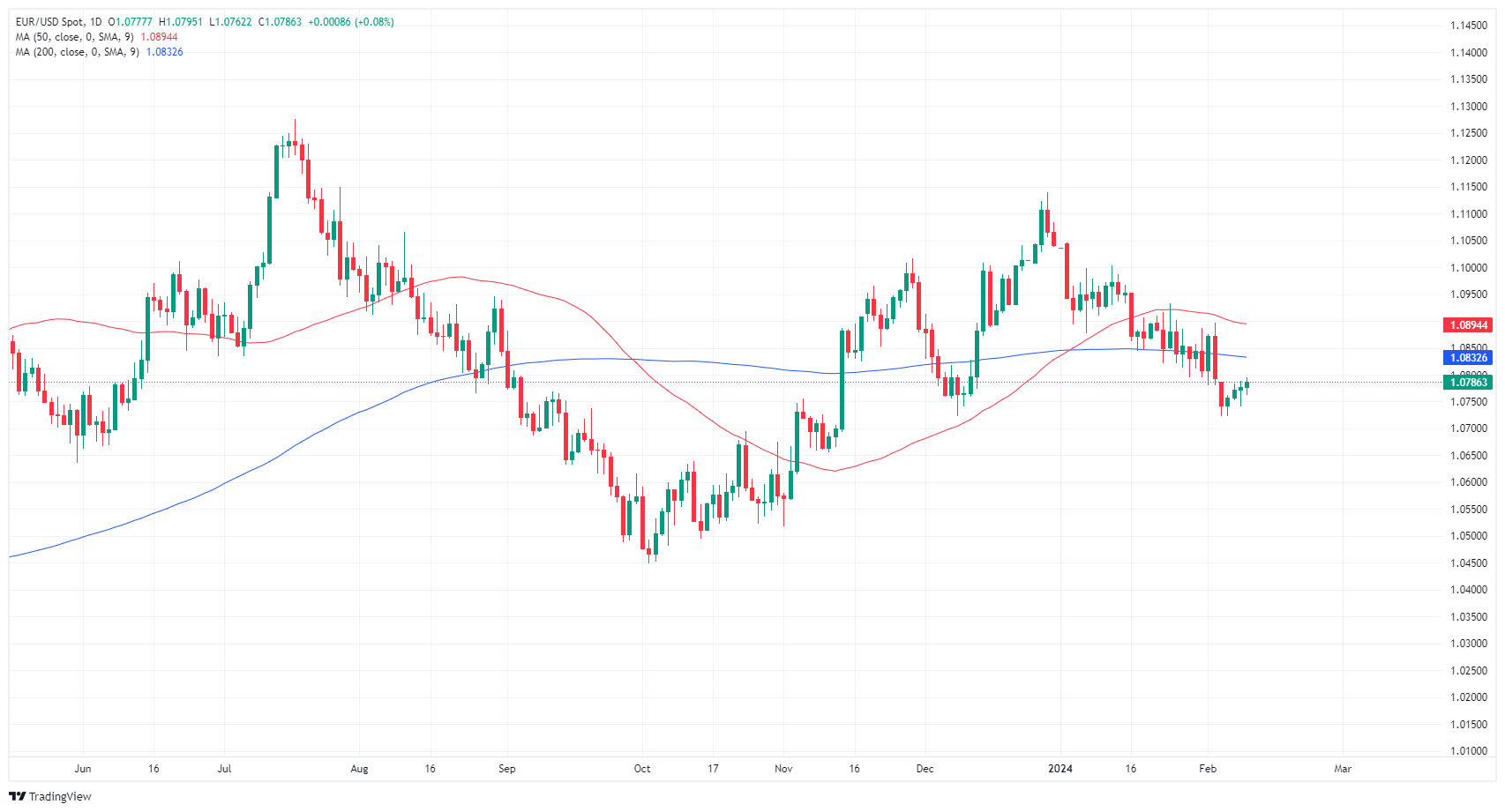EUR/USD managed to climb slightly higher on Friday but struggled to gather significant upward momentum. Despite this modest recovery, the pair remained below the key resistance level of 1.0800. The latest German inflation data confirmed earlier estimates, showing no surprises, while adjustments made by the US Bureau of Labor Statistics regarding seasonal adjustments in the CPI figures didn’t cause significant market fluctuations.
In more detail, Germany’s final Harmonized Index of Consumer Price (HICP) for January remained unchanged from preliminary readings, indicating an annualized inflation rate of 3.1%. Meanwhile, revisions to the US December monthly CPI showed a slight adjustment from 0.3% to 0.2%. Looking ahead to the following week, investors are awaiting fresh US CPI inflation data, with expectations of a slight decrease from 3.4% to 3.0% year-on-year for January.
Additionally, European Gross Domestic Product (GDP) figures are scheduled for release, with forecasts suggesting that pan-European GDP growth will remain subdued. The anticipated quarterly EU GDP is expected to be in line with previous figures, printing at 0.1%. These upcoming economic indicators will likely influence market sentiment and trading dynamics for the EUR/USD pair.
Euro price today
The table below shows the percentage change of Euro (EUR) against listed major currencies today. Euro was the strongest against the Swiss Franc.
| USD | EUR | GBP | CAD | AUD | JPY | NZD | CHF | |
| USD | -0.09% | -0.09% | 0.00% | -0.43% | 0.00% | -0.75% | 0.13% | |
| EUR | 0.09% | 0.00% | 0.09% | -0.35% | 0.08% | -0.66% | 0.22% | |
| GBP | 0.09% | -0.01% | 0.10% | -0.34% | 0.09% | -0.66% | 0.22% | |
| CAD | -0.01% | -0.09% | -0.09% | -0.42% | -0.01% | -0.76% | 0.12% | |
| AUD | 0.43% | 0.32% | 0.32% | 0.41% | 0.42% | -0.32% | 0.56% | |
| JPY | 0.01% | -0.08% | -0.07% | 0.00% | -0.44% | -0.72% | 0.15% | |
| NZD | 0.75% | 0.66% | 0.66% | 0.75% | 0.32% | 0.75% | 0.88% | |
| CHF | -0.14% | -0.23% | -0.22% | -0.13% | -0.56% | -0.13% | -0.89% |
The heat map shows percentage changes of major currencies against each other. The base currency is picked from the left column, while the quote currency is picked from the top row. For example, if you pick the Euro from the left column and move along the horizontal line to the Japanese Yen, the percentage change displayed in the box will represent EUR (base)/JPY (quote).
Technical analysis: EUR/USD struggles to grow legs beneath technical recovery
The EUR/USD remains pinned on the south side of the 200-hour Simple Moving Average (SMA) just beneath 1.0800. Although the pair continues to recover into the upside from the early week’s bottom near 1.0725, topside momentum remains capped, with longer-term technical patterns remaining decidedly bearish.
Despite posting three straight days of gains and on pace for a fourth, the EUR/USD remains on the bearish side of the 200-day SMA at 1.0833. The pair is still down over 3% from late December’s peak of 1.1140, and Euro bidders are struggling to lift the Euro off the floor of a nearly 4% decline into January’s bottom bids of 1.0722.
EUR/USD hourly chart
EUR/USD daily chart
RISK SENTIMENT FAQS
What do the terms”risk-on” and “risk-off” mean when referring to sentiment in financial markets?
In the world of financial jargon the two widely used terms “risk-on” and “risk off” refer to the level of risk that investors are willing to stomach during the period referenced. In a “risk-on” market, investors are optimistic about the future and more willing to buy risky assets. In a “risk-off” market investors start to ‘play it safe’ because they are worried about the future, and therefore buy less risky assets that are more certain of bringing a return, even if it is relatively modest.
What are the key assets to track to understand risk sentiment dynamics?
Typically, during periods of “risk-on”, stock markets will rise, most commodities – except Gold – will also gain in value, since they benefit from a positive growth outlook. The currencies of nations that are heavy commodity exporters strengthen because of increased demand, and Cryptocurrencies rise. In a “risk-off” market, Bonds go up – especially major government Bonds – Gold shines, and safe-haven currencies such as the Japanese Yen, Swiss Franc and US Dollar all benefit.
Which currencies strengthen when sentiment is “risk-on”?
The Australian Dollar (AUD), the Canadian Dollar (CAD), the New Zealand Dollar (NZD) and minor FX like the Ruble (RUB) and the South African Rand (ZAR), all tend to rise in markets that are “risk-on”. This is because the economies of these currencies are heavily reliant on commodity exports for growth, and commodities tend to rise in price during risk-on periods. This is because investors foresee greater demand for raw materials in the future due to heightened economic activity.
Which currencies strengthen when sentiment is “risk-off”?
The major currencies that tend to rise during periods of “risk-off” are the US Dollar (USD), the Japanese Yen (JPY) and the Swiss Franc (CHF). The US Dollar, because it is the world’s reserve currency, and because in times of crisis investors buy US government debt, which is seen as safe because the largest economy in the world is unlikely to default. The Yen, from increased demand for Japanese government bonds, because a high proportion are held by domestic investors who are unlikely to dump them – even in a crisis. The Swiss Franc, because strict Swiss banking laws offer investors enhanced capital protection.







